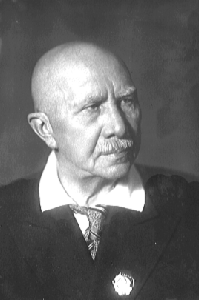presents
 Serafimovich, Alexander. Alexander Serafimovich
Popov (aka Serafimovich), a genuine Don Cossack, was born on 19
January 1863 in the village of Nizhne-Kurmoyarskaya, 100 miles east
of Rostov-on-Don. At age three, he and his family moved to Poland
with his father, who was stationed there with a
Cossack regiment. In 1874, they returned to the Don and settled in
Ust-Medveditskaya (later renamed Serafimovich).
Serafimovich, Alexander. Alexander Serafimovich
Popov (aka Serafimovich), a genuine Don Cossack, was born on 19
January 1863 in the village of Nizhne-Kurmoyarskaya, 100 miles east
of Rostov-on-Don. At age three, he and his family moved to Poland
with his father, who was stationed there with a
Cossack regiment. In 1874, they returned to the Don and settled in
Ust-Medveditskaya (later renamed Serafimovich). After his father's death, he secured a military scholarship and studied mathematics and physics at the University of Petersburg. He met Alexander Ulyanov, Lenin's older brother, and joined a revolutionary student group. In 1887 he was arrested for writing a proclamation about the attempted assassination of Alexander III. He was exiled to Mezen in Archangel Province in the far north for three years. In 1890 he returned to Ust-Medveditskaya, then moved to Novocherkassk and Rostov-on-Don, surviving by giving lessons and contributing sketches to local newspapers. During this time, he got involved in People's Will groups and carried on propaganda for them. In 1902 he moved to Moscow and dedicated himself to writing. In 1903 he joined Maxim Gorky's cooperative publishing enterprise Znanie, which published three volumes of Serafimovich's stories. He participated in the 1905 Revolution in Moscow's Presnya district. He traveled to Finland in 1910. In 1915, after the outbreak of World War I, he went to Galacia where he and Lenin's sister, Maria Ulyanova, served as medical orderlies. He was also correspondent for Russkiye Vedomosti. He was one of the first writers to support the October Revolution and was given responsibility for the artistic section of Izvestiya. In March 1918 he was at the civil war front as a correspondent for both Izvestiya and Pravda. He joined the Communist Party in 1918. After the Civil War he was active in editorial work as a board member of Tvorchestvo and chief editor of Oktyabr. He was awarded the Stalin Prize (1943), Order of the Red Banner and Order of Lenin. He died in Moscow on 19 January 1949. His main novel, The Iron Flood (Zheleznii Potok, 1924), describes the march of the Taman Army between late August and mid-September 1918. In it, a rag-tag army and thousands of tag-along refugees start out squabbling, undisciplined, and disorganized as they attempt to flee from some pursing Cossacks and join up with the main Red Army units. They escape annihilation only by finally uniting and submitting to the iron will of their newly elected commander, who promises death as punishment for the slightest insubordination. (Remind you of anyone?) It depicts mass action, mass mentality and the class essence of the Civil War. Other works: On an Ice-Floe (1889), a story of hunters on the White Sea. The Snow Desert (1889). On Rafts (1890). The Switchman (1891), a railway story. In The Health Resort (1902), a tale set in Yalta where Serafimovich himself has received treatment for tuberculosis. Into the Storm (1903), a fishing tale. On the Shore (1903), another fishing tale. In Presnya (1906), The Bombs (1906), and How They Were Hanged (1908) reflect his experience during the 1905 revolution. In the Middle of the Night (1906) contains a portrayal of a workers' mass meeting in the Crimea. The Glow of the Fire (1907), describes the burning of church estates. At the Precipice (1907) shows punitive measures taken by the authorities after the events of 1905. Forest Life (1908), set in Archangel province. Sands (1908), a story of peasant greed and murder, was praised by Lev Tolstoy. Chibis (1908), a sad tale about a homeless family of farm laborers roaming the Don country. A Town in the Steppe (1912), his first novel, tells the tale of the struggle between capitalists and proletarians as a new industrial town is built in the Don steppes. Three Friends (1914), about life on a small farm in the Don. Short Summer Night (1916), deals with exploitation of children. The Black Three-Cornered Cap (1914) and Thermometer (1914) deal with the poverty and suffering of ordinary people during wartime. The Revolution, the Front and the Rear (1917-1920), a series of civil war sketches and tales. Two Deaths (1926) is story of a woman who volunteers to spy on the White cadets during street-fighting in Moscow following the Revolution. Over the Don Steppes (1931) is a series of sketches about the live of the Don Cossacks. Collective Farm Fields and an autobiographical novel remained unfinished at his death. Source: Luker, Nicholas. "From Furmanov to Sholokhov", Ardis 1988. |